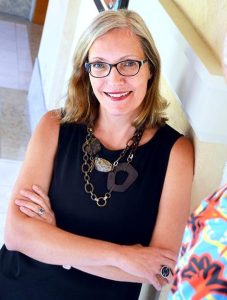
It’s a changing of the guard at the Boca Raton Museum of Art, as current executive director Irvin Lippman steps down in January after 11 years, turning the leadership over to Ena Heller, who comes to Boca Raton from Winter Park, where she was the Bruce A. Beal Director of the Rollins Museum of Art.
Under Lippman’s direction, the museum transformed itself with popular exhibitions such as the Art of the Hollywood Backdrop and Machu Picchu and the Golden Empires of Peru exhibits and with a $1.8 million renovation to open the museum’s exterior to the public.
“I am thrilled to welcome Ena Heller to work with us at the Boca Raton Museum of Art,” says board chair John DesPrez. “Ena brings a unique combination of extensive experience managing art museums coupled with true academic credentials in the arts.”
Heller begins her new position on February 3.
“I’m very excited for this opportunity,” says Heller, who has master’s and doctoral degrees from the Institute of Fine Arts at New York University, and worked at the Metropolitan Museum of Art and the Museum of Modern Art in New York City.
“I look forward to coming down and getting started,” she says.
Born in Bucharest, Romania, Heller came to this country as a political refugee with her family in 1988. Now married to Robert Heller, a retired executive, the couple has one daughter, Eliane, 24, who works for a public affairs and government relations firm in Washington, D.C.
Inheriting her in-laws’ home in Delray Beach, the Hellers are no strangers to the area, having come to Delray over the past 25 years to enjoy the vibrant nature of the city and its beaches.
At the Rollins Museum of Art, Heller oversaw the acquisition of more than 1,300 pieces to the permanent collection, exhibited the museum’s contemporary collection in The Alfond Inn, a local boutique hotel, quadrupled the number of visitors and spearheaded the design of the new museum building.
She also doubled the operating budget and created the first endowment for exhibitions.
She came to Rollins in 2012 from the Museum of Biblical Art (MOBIA) in New York City, where she was founding executive director. She also taught at the College of the Holy Cross in Worcester, Mass., and at Manhattanville College in Purchase, N.Y.
Heller is excited to come to Boca Raton, which she calls “a familiar place and a wonderful community,” and immerse herself in the environs, listen to constituents and form a joint vision with the board of directors.
Informed by Lippman that the Boca Raton Museum of Art has a definite personality and is a “museum with a soul,” Heller says while she’s not yet sure what that personality is, she looks forward to discovering it.
“Irvin is beloved by the community,” Heller says, “and has done a lot for the museum, the city and the community. I hope to be a worthy successor and elevate the platform he’s built even more.”
As much as the museum has grown and evolved over the past decade, Heller believes she has the skill set to identify and tap into the museum’s potential and bring it to the next level.
“We need to think about ways to collaborate and position the museum as an innovative partner and become a cultural hub that will create excitement, new synergies and new ideas,” she says.
Heller notes that the city of Boca Raton will celebrate its centennial anniversary in 2025, the museum will turn 75, and plans for the city’s culture hub in Mizner Park, the Center for Arts and Innovation, are underway.
“It’s an exciting time for the city,” she notes. “This is an opportunity to partner with established institutions and think about things differently.”
Heller is impressed with Lippman’s final accomplishment – the just-opened exhibit Splendor and Passion: Baroque Spain and its Empire, organized by The Hispanic Society of America with paintings by El Greco, Diego Valázquez, and Bartolomé Esteban Murillo.
“It’s not often you see Spanish Baroque paintings in Palm Beach County,” she says. “The exhibition enlarges the conversation in the South Florida region and allows the museum to cast a wider net for visitors.”
She believes the museum is at an inflection point, with the potential to become a greater resource for the city and the region and expand its educational and exhibition programming.
Another challenge is one all museum directors share.
“How do we make museums more open and inclusive?” she asks.
“Museums are no longer a passive experience where viewers look at the art on the wall,” Heller says. “This is no longer the only museum experience. Young people want to write their own script and engage on their own terms.”
Engagement through participatory exhibits is high on her to-do list.
As far as the legacy of the museum, Heller hopes to raise the museum’s profile by capitalizing on aspects of the museum that set it apart from its counterparts.
Because the museum has an art school and education is a part of the museum’s mission, Heller believes these are areas that can be enlarged and developed.
What does Heller want South Floridians to learn about her?
“I hope they see me as someone who loves art and loves teaching with art,” says Heller. “My entire career is dedicated to making art accessible to a wider audience.”
“Art is a point of entry,” she says. “You don’t have to know much about art to benefit from engaging with it.
“If you leave learning one thing, I will have done my job,” Heller says. “Art makes life better.”